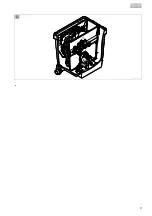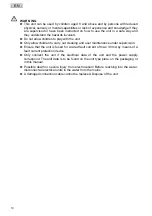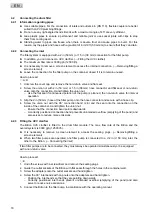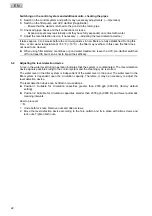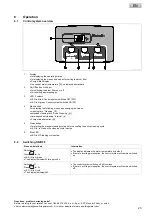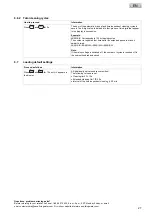
- EN -
16
3.3 Function
description
ProfiClear Premium Compact combines the removal of coarse dirt particles and biological filtration in
one unit. Screens (80
μ
m) separate all types of dirt particles before the water reaches the biological
filtration. By separating the suspended solids, the filter removes most of the nutrient matter from the
water. Following this mechanical filtration, the Hel-X biomedia in the moving bed system carry out the
biological filtration of the pond water.
The control system with an integrated micro-controller system automatically controls and monitors the
filtration process. The automatic self-cleaning function can be individually adjusted to meet the user's
requirements.
Hel-X bio-elements
ensure the effective break-down of nutrients and contaminants in the water. Over
the course of time, the surface of the bio-elements is colonised by bacteria responsible for nitrification
and denitrification. They clean the water before it leaves the container. The fluidized bed process (action
of the water flow and oxygen supply) and the bypass technology ensure optimum movement of the Hel-
X bio-elements even at high flow rates. The biological system is self-cleaning and does not need
additional maintenance.
40 l of Hel-X biomedia can break down the nutrients of approx. 9.5 oz (270 g) of fish food per day,
given optimum conditions. If required, this can be increased to 60 l, i.e. 14.4 oz (408 g) of fish
food per day.
The development of the micro-organisms in the filter takes several days. It can be accelerated by adding
biological starter bacteria.
BioKick
contains millions of active micro-organisms. They start cleaning the water immediately. The
biology in the filter is fully developed within only a few weeks.
Nitrification
is the process by which ammonia/ammonium and nitrite are removed from the water by
special bacteria. These substances can build up in the water, for example as a result of fish food and
fish excrement. Ammonia is particularly toxic for fish.
Nitrification takes place in two steps. In the first step, the bacteria convert the ammonia/ammonium into
nitrite. In the second step, other bacteria convert this nitrite into nitrate, which although non-toxic,
promotes the growth of algae. Both steps use oxygen that is taken from the water.
Denitrification
is the process by which nitrate is broken down to gaseous nitrogen. In the event of a low
oxygen content, the bacteria use the nitrate nitrogen as a source of oxygen and convert it into
atmospheric nitrogen. Atmospheric nitrogen cannot be used by algae and aquatic plants.
3.4
Easy Garden Control System (EGC)
This product can communicate with the Easy Garden Control-System (EGC). EGC allows convenient
control in the garden and pond via smartphone or tablet, and ensures maximum convenience and
reliability. Information about EGC and the possibilities it offers can be found at
www.oase-
livingwater.com/na/egc
.
4
Installation and connection
Important
: If the planned installation deviates significantly from the recommendations contained in this
manual:
►
Have your specialist retailer check whether all technical specifications were adhered to. This is
crucial for a problem-free operation.
Summary of Contents for ProfiClear Premium Compact-M EGC
Page 2: ...2 A ProfiClear0176...
Page 3: ...3 B ProfiClear0177 C ProfiClear0172...
Page 4: ...4 D ProfiClear0112 E BTC0027...
Page 5: ...5 F G ProfiClear0167 ProfiClear0168 H ProfiClear0169 I ProfiClear0170...
Page 7: ...7 N BTC0031 O PrifiClear0083 P BTC0025...
Page 8: ...8 Q ProfiClear0084 R ProfiClear0085 S T BTC0023 BTC0024...
Page 9: ...9 U ProfiClear0178 s...
Page 92: ...OASE GmbH www oase livingwater com Tecklenburger Stra e 161 48477 H rstel Germany 72631 02 19...








